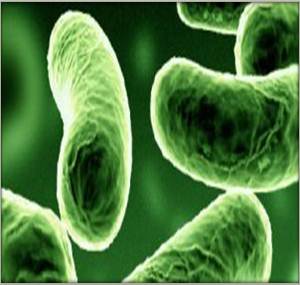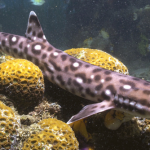Yes, like humans (all other animals on Earth), sharks have a gut microbiome too. Everyone’s just been way too busy talking about all that Megalodon crap to think about this *real* and much cooler science.
There is a diverse and abundant gut microbiome associated with finfish, sharks, and blue crabs. These gut microbiomes all have a core Proteobacteria community, which is in contrast to the human and terrestrial mammalian gut microbiome which is dominated by Firmicutes and Bacteroidetes ribotypes. This difference may partly be attributed to the fact that some of these Proteobacteria (such as Vibrio spp. and Photobacterium spp.) are typically associated with aquatic environments. [Givens, 2012[
As Al mentioned, Sharks have crazy gut anatomy. Their intestinal tract is short, and so in order to increase surface area in the gut and maximize the adsorption of nutrients, they have this badass spiral valve:

So it’s not surprising that the microbial species inhabiting the shark gut would be so different from humans and other mammals. And what species of microbes, you ask?
The core gut microflora of the shark species we tested (sharpnose, spinner, and sandbar) contained Cetobacterium sp., Photobacterium sp. and Vibrio sp., with Photobacterium ribotypes dominating the core group of all three shark species…Our data indicate that Actinobacteria, Firmicutes (Clostridium sp), Fusobacteria (Cetobacterium sp.), and other Proteobacteria (Campylobacter sp. and Vibrio sp.) are also important members of the shark gut microbiome. Our findings also indicate that shark gut microbiomes have less richness and diversity than most finfish guts we sampled.
…we did not find a core microbial assemblage that encompassed all of the fish species we sampled. This is consistent with an analysis of fecal microflora reported by Ley et al. (2008), which found that no OTUs [DNA sequences of microbe species] were shared by all mammalian species sampled (humans and 59 terrestrial mammals). Our results suggest that the gut microflora of each species assembles in response to the fish’s specific physiological demands and dietary needs. [Givens, 2012]
Ok, so shorter gut also seems to lead to fewer gut microbes – but the exact community might be pretty variable based on the shark species, what they eat, and where they live.
And the presence of Photobacterium microbes in the shark gut is pretty cool – but also pretty confusing when you think about it. Microbes in this group are either A) are the symbionts responsible for bioluminescence in light organs of marine species, or B) pathogens responsible for septicemia, blood poisioning, in both fish and humans. I’d love to know the metabolic role of Photobacterium in the shark gut, since it is clearly a key player in the shark microbiome.

Why is the shark microbiome less diverse? Why is it so different from other bony fish? What is the functional role of these major microbe groups reported from the shark gut? The science on the shark microbiome very preliminary right now, but shark-associated microbes are most definitely worth your consideration during Shark Week!
Reference:
Givens, Carrie E (2012) A FISH TALE: COMPARISON OF THE GUT MICROBIOME OF 15 FISH SPECIES AND THE INFLUENCE OF DIET AND TEMPERATURE ON ITS COMPOSITION. PhD Thesis, University of Georgia






Great piece! Just a small correction, though: sharks are in Chondricthyes, the cartilagenous fish. So they’re not bony (class Osteichthyes, a more ancient lineage) as you say towards the end of the article.